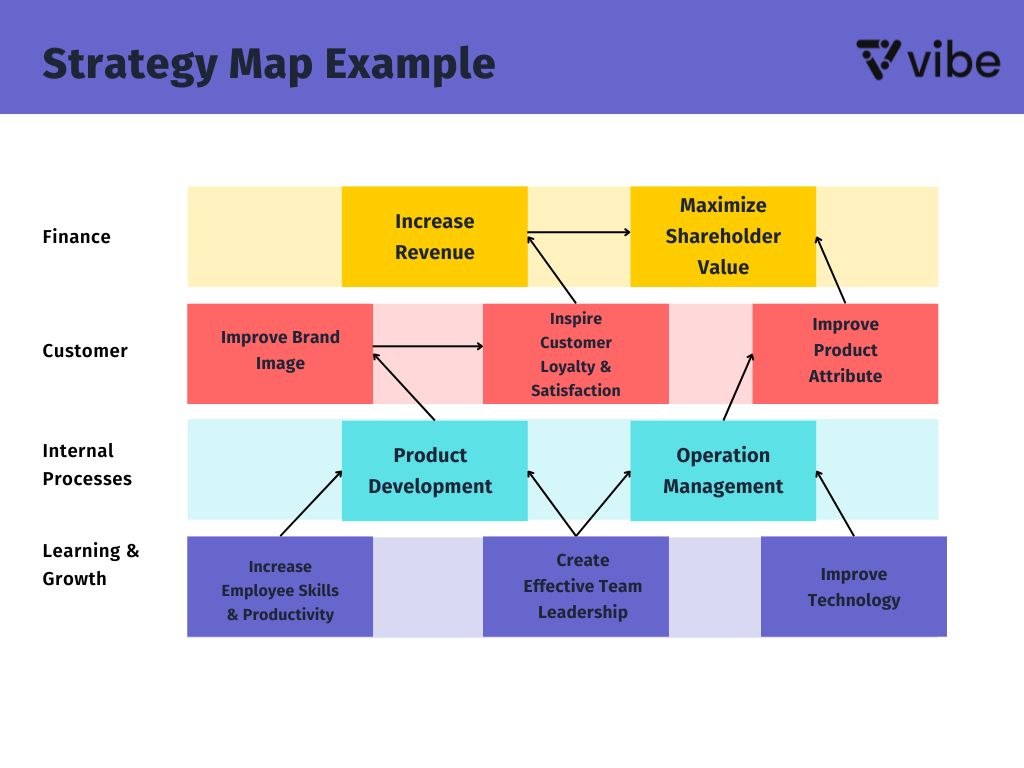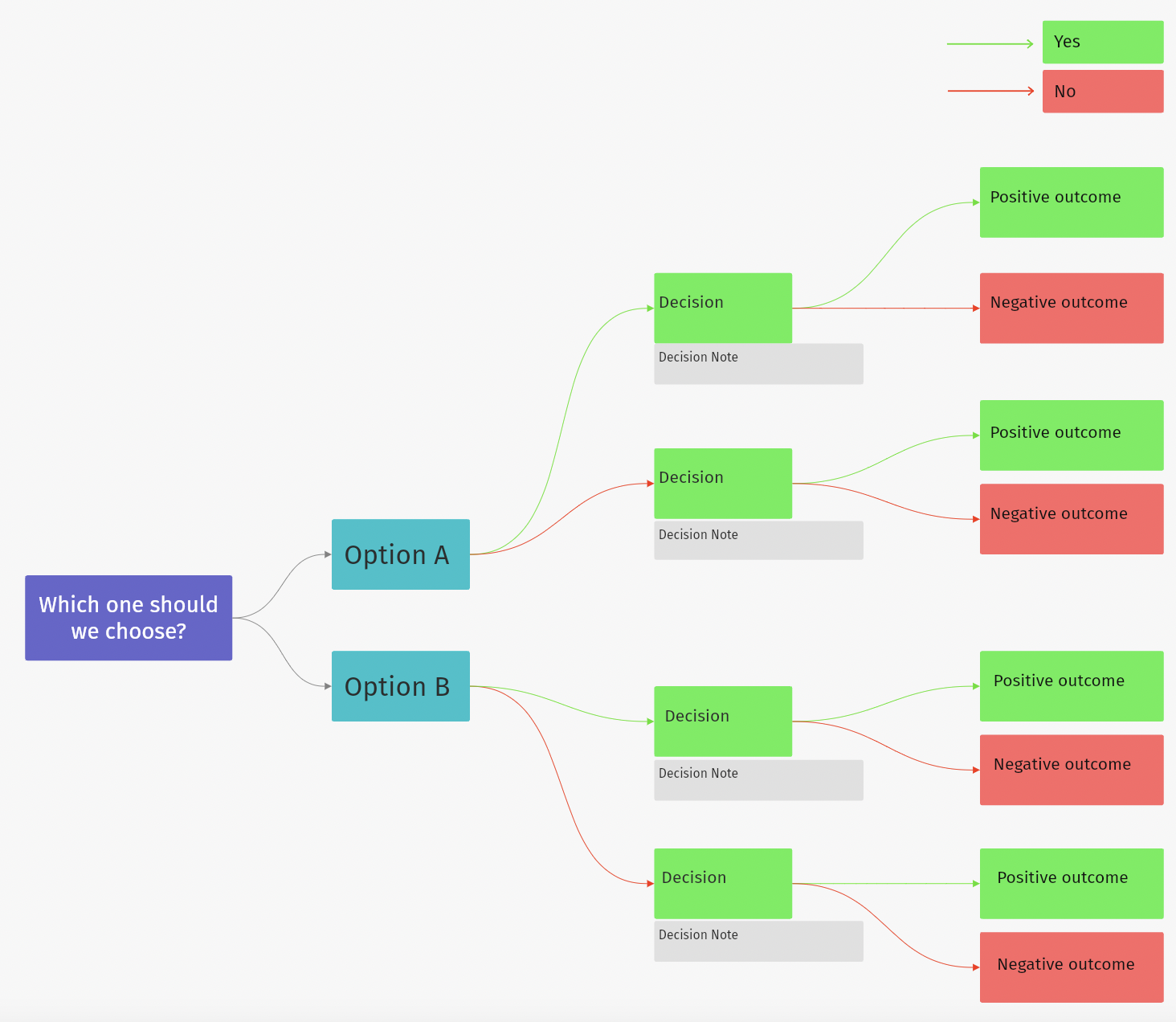Planning for the future of your company is a great way to guarantee its success, especially as your business expands and changes to meet the demands of clients and customers, and with a strategy map, it’s easier than ever.
One of the numerous tools that you might use in the process of planning is called a strategy map. It’s an effective tool for managers who require a visual representation of their company’s overall goals.
This article will describe what a strategy map is, how to use it, its advantages, and how to create one. Let’s get started!
What Is a Strategy Map?

A strategy map is a graphical representation of a company’s goals and objectives in the areas of business growth, client acquisition, and financial health.
Robert S. Kaplan and David P. Norton popularized the use of strategy mapping to illustrate how businesses convert intangible resources and organizational resources into tangible, bottom-line-positive results. It offers a standardized structure and terminology for talking about the fundamental actions involved in implementing a successful business strategy that improves the likelihood of survival.
In other words, a successful strategy map illustrates how a company converts its resources and manpower into operational and financial benefits.
In addition, many businesses find strategy maps helpful because they include intangibles like company culture in the analysis of strategic options. The ability to brainstorm the organization’s goals from several angles is one of the many benefits of creating a strategy map.
How Do Strategy Maps Work?

Strategy mapping mainly works as the catalyst for improving any kind of strategy communication endeavor. Most people in a workplace are visual learners, so creating a visual picture of your business strategy will be far more effective than a written narrative to make people understand.
In addition, the method of creating a strategy map compels the team to reach an agreement on the goals they’re trying to achieve—and helps everyone express those goals in terms that are simple and easy to comprehend. If a strategy map is carefully crafted, every employee will be able to understand how their contributions fit into the larger picture of the organization’s goals.
A typical strategy map template includes four major perspectives:
-
Finance
-
Customer
-
Internal Processes
-
People/Learning & Growth
The first two points deal with "what we’re getting," whereas the second two emphasize "what we’re doing." The topmost aspect represents the lagging goals and indicators, while the bottom two represent the leading actions and goals. A map may be examined either from the top to bottom or vice versa, but the point of the strategy is more easily understood when viewed from the bottom up, as the actions you do have a direct impact on the results you see.
Benefits of Strategy Maps

Some of the many advantages of adopting a strategy map in your business are:
1. Effective Planning
Whether you’re using a strategy map by itself or adding to other planning processes, taking the time to think about your company’s strategy can help you make better plans. While understanding your goals is important, recognizing the interconnected nature of your goals and how progress toward one may pave the way to the accomplishment of others is also important. This might help you prioritize which of your goals to work on first or figure out how to get the most value for your money.
2. Color-coded Status
Using color coding to show the progress toward various targets is a breeze on a strategy map. Because of this, it’s easier to check in on progress toward the goal. For instance, if you’ve made progress toward your goal of increasing efficiency in the six months after you first created the strategy map, you may highlight that progress with a specific color. Goals that have been completed previously would be one color, while those that have seen no progression would be another.
3. Customizable
Whether you are creating them on a smart whiteboard or your computer, you can customize strategy maps to fit the specific requirements of your business. While most will contain the four-goal categories, you’re free to rename or rearrange them to better represent the priorities of your own team or corporation. You and your team can use whatever visual style you choose for your strategy map, and you’re free to choose the colors you want to use to indicate progress toward your goals.
4. Clear Employee Roles
A strategy map is a clear indication of the roles of each employee. It’s possible that in cases of very high-level planning processes, the specific job of each person may be less evident. Since the most important goals should be obvious to even the most junior members of staff, strategy maps are a fantastic tool for communicating these goals across the whole business.
5. Interconnection Between Goals
A key benefit of a strategy map is that it makes the connections between goals visible. It is more difficult to see the interconnectedness of several goals in a written text. The visual indicators in a strategy map help in making it evident how the goals connect. This may help illustrate to coworkers how their efforts contribute to company-wide success.
What Are Strategy Maps Used For?

Strategy maps are typically used for the following:
-
Strategy mapping: Get a fresh perspective on your ideas and strategies in a nutshell.
-
Establish the context: Maximize your team’s potential by making sure everyone knows how crucial their role is to the company’s success.
-
Keeping them updated: Any employee can see the big picture and how their job affects the company as a whole.
-
Easy monitor: See clearly where you are about other projects and teams throughout your whole business.
-
Better team alignment: Find out whether your teams are working together, and if there are any inefficiencies you can fix before they become major issues.
How to Build a Strategy Map

Here are the key steps to creating an effective strategy map:
1. Establish Goals, Missions, and Values
That’s where your company has to go to find its direction. These three things will assist you in making the best judgments possible when faced with uncertainty.
2. Define Four Perspectives
You need to determine what your perspectives will be concerning the four variants of the strategy map. You can base each of these on the needs of your organization.
3. Establish Strategic Priorities
Strategic priorities are long-term goals; often, they include better customer service, improved sales processes, and improved production.
4. Create Organizational Goals
The next step is to define your business goals in your strategy map, linking each goal with another based on cause and effect. As mentioned, the goals from the bottom perspective determine the planning of the goals from the top perspective.
5. Describe Rationale
The term "rationale" refers to the logic behind why you have chosen this particular goal. Elaborate in the goal’s description section as to why you’ve chosen to go toward that particular goal.
6. Identify Leading and Lagging Indicators
What exactly do you mean when you talk about organizational goals? Setting up a set of advanced and retrospective measures with reference points may help shed light on this subject. Once metrics for achievement have been defined, even the vaguest goal can be articulated with clarity.
7. Outline Initiatives
An organization’s initiatives are its high-level action plans for putting the strategy into action.
8. Build Area-Wise Strategies
While the corporation as a whole should have a single overarching strategy, its many departments will be responsible for a unique aspect of that plan. Develop enhanced strategy maps for your area, including more nuanced goals and metrics.
Use Vibe Interactive Whiteboard to Build Your Strategy Map

The Vibe Board is an interactive whiteboard software tool that helps you create precise strategy maps for achieving the goals of your organization. Vibe allows you to arrange your thoughts on pre-built templates, with lifelike brush tools, split-screen mode, and an infinite digital Canvas—so you’re not confined to the dimensions of a sheet of paper or blackboard.
With Vibe, you can collaborate in real time on a single strategy map to create and discuss your strategies all at once, whether your team is in the same room or working across the globe. With everything automatically saved in the cloud, sharing your strategy maps is straightforward, and creating presentable diagrams is an efficient meeting technique. Use the Vibe Board to make your whole strategy map creation process quick and seamless.
FAQs
1. Are there multiple strategy maps?
The type of strategy map you use depends on the needs and goals of your organization. That being said, all strategy maps follow the same four perspectives:
-
Finances – Primarily measures revenue growth and productivity.
-
Customers – Determines custom value proposition.
-
Processes – Explores how a business can improve customer and financial goals. Examples include market expansion, innovation, improving customer relationships, etc.
-
Learning and growth – Specifies the abilities of employees to enable the smooth operation of procedures.
2. Can anyone use a strategy map?
Yes! Any business can use a strategy map. For a company’s growth, an effective strategy session is essential, and strategy mapping is extremely helpful in that regard. People tend to learn best via visuals; thus, a picture of your plan will be understood by many more workers than a description of it in words. In addition, creating a strategy map compels the group to settle on a common definition of success in clear, concise language. A well-drawn map will show each employee how their work fits into the bigger picture of the company’s goals.








-1sbltxxq4FYxHrXrwJVLsCDNsXpqNa.webp)
-5Zp0pmSytvcuYDVs1LvuwplKuRneK0.webp)

